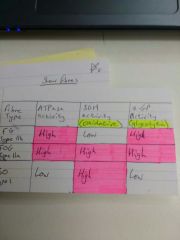![]()
![]()
![]()
Use LEFT and RIGHT arrow keys to navigate between flashcards;
Use UP and DOWN arrow keys to flip the card;
H to show hint;
A reads text to speech;
30 Cards in this Set
- Front
- Back
|
Very fast muscle fibres need? Leaving less space for? |
Lots of myofibrils, Less space for other organelles |
|
|
High force requires? Leaving less space for? |
Requires lots of SR, less space for mitochondria. |
|
|
3 ways slow fibres are different to fast |
-Smaller diameter -Darker color due to myoglobin (the haemoglobin of the muscle world) -Fatigue resistant |
|
|
Table of fibres type vs different kinds of activity (e.g. ATPase) |

|
|
|
How much ATP per glucose do aerobic and anaerobic respiration provide? Which is fast/slow? |
Aerobic- slow, but 36ATP per glucose Anaerobic- fast, 2ATP per glucose (uses local energy stores) |
|
|
CT cells: general functions of fibrocytes and macrophages |
Fibrocytes: repair and maintain CT networks Macrophages: scavenger cells that engulf both damaged cells and pathogens |
|
|
2 things collagen is a major component of? |
Tendons and ligaments. |
|
|
6 cell types of CT proper |
Fibroblasts, fibrocytes, mast cells (+lymphocytes, microphages), macrophages, adipocytes, mesenchymal cells. |
|
|
What are mesenchymal cells? |
CT specific stem cells |
|
|
Where are dense regular and dense irregular tissues found? |
Dense regular- in tendons and ligaments Dense irregular- protective capsule around organs |
|
|
What does dense regular tissue contain a lot of? |
Fibroblasts |
|
|
3 things formed in cytosol |
Initiate peptides, polysaccharides, fatty acids. |
|
|
What transiently attached ribosomes to ER |
Initiate peptides |
|
|
1 thing that happens to peptides in the ER and also in the golgi |
Protein Glycosylation (addition of a carbohydrate) |
|
|
2 things synthesised in peroxisomes |
Bile salts and complex fatty acids. |
|
|
What do glyoxisomes do? |
Make sugar from fat via the glyoxylate cycle |
|
|
2 things fibroblasts do |
Secrete procollagen, which is cleaved for collagen Secrete Hyaluronan, which forms a polysaccharide gel like base |
|
|
What creates the supporting CT matrix? Out of what? (3) |
Chondrocytes make the matrix Thick gel like matrix of: proteoglycans, chondroitin sulfates and filaments. |
|
|
What is similar about formation of reticular fibres and collagen fibres? |
Both start with alpha helices |
|
|
5 steps of signal recognition and transport into ER |
1) Signal+ribosome binds to SRP 2) SRP binds to SRreceptor 3) Forms complex with translocon 4) Chaperon helps fold 5) SignalPeptidase cleaves signal |
|
|
What do phosphotidylcholine membranes look like? |
Cylindrical, more or less flat monolayers. |
|
|
What is Zellweger syndrome? |
Absence of all peroxisomes. |
|
|
What is the type of phospholipid only normally found on inside leaflet |
Phosphotidylserine |
|
|
What kind of molecule are blood markers? |
Glycosphingolipids |
|
|
3 sources of ATP for muscle contraction |
Phosphocreatine Glycolysis Oxidative phosphorylation |
|
|
What's the tension-resistance relationship for isotonic contractions? |
Isotonic: muscle tension peaks when it equals the amount of resistance |
|
|
What's the tension-resistance relationship for isomeric contractions |
Isomeric: resistance is greater than muscle tension capacity Tension peaks at capacity, which is less than the resistance |
|
|
Two types of isotonic muscle contraction |
Concentric= pull Eccentric= push |
|
|
5 steps in skeletal muscle formation |
1) specification- stem cells to myoblasts 2) proliferation and migration 3) fusion of myoblasts 4) formation of primary myotube 5) maturation into a muscle fibre |
|
|
What surrounds: muscle fibres? Bundles of muscle fibres? Entire muscle? |
Muscle fibres- endomysium Bundles of muscle fibres- perimysium Entire mistake- epimysium |

